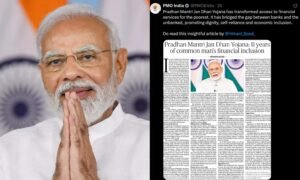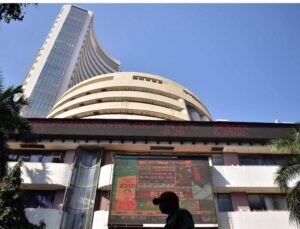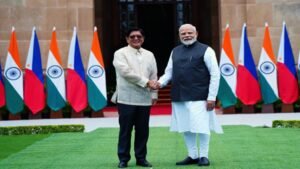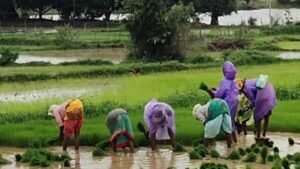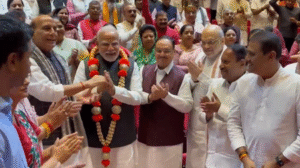From income tax exemption, Kisan Credit Card to cheap and expensive things, understand the budget in common parlance

New Delhi| Highlights of Budget 2025-26
1. India’s economy is the fastest growing among all major global economies. Over the past 10 years, the Modi government’s development track record and structural reforms have attracted significant international attention.

2. The transformative work done during the first two terms of this government serves as a guide, enabling this government to move forward with determination.
3. Development measures have been proposed in various sectors focusing on youth, Annadata and women (poor, youth, farmers, women).

Income tax relief
1. Democracy, demography and demand are key supporting pillars in our journey towards a developed India. The middle class provides strength to the development of India.
2. The NDA government led by Honorable Prime Minister Modi has always believed in the commendable energy and potential of the middle class in nation building.
3. In recognition of their contribution, the government has reduced their tax burden from time to time. Just after 2014, the ‘zero tax’ slab was increased to ₹2.5 lakh, which was increased to ₹5 lakh in 2019 and ₹7 lakh in 2023.
4. Under the new system, no income tax will have to be paid on income up to Rs 12 lakh (i.e. average income of Rs 1 lakh per month excluding special rate income like capital gains).
5. For the salaried class, no income tax is applicable up to an annual income of ₹12.75 lakhs, since a standard deduction benefit of ₹75,000 is available to the salaried class.
The total tax benefit of slab rate changes and exemptions at different income levels can be illustrated by examples.
In the new regime a taxpayer with an income of ₹12 lakhs will receive a benefit of ₹80,000 in tax (100% of the tax payable will be exempt according to the current rates). The effective income tax rate shall be 0%.
1. A person with income of 1.6 million will receive a benefit of ₹50.000 in tax. [The effective income tax rate payable will be just 7.5%]
2. A person with income of 1.8 million will receive a benefit of ₹70.000 in tax. [The effective income tax rate payable will be just 8.8%]
3. A person with an income of Rs 20 lakh will get a benefit of Rs 90,000 in tax. [The effective income tax rate payable will be just 10%].
4. A person with an income of Rs 25 lakh will get a benefit of Rs 1,10,000. [The effective tax rate will be just 13.2%]
5. A person with an income of Rs 50 lakh will also get a benefit of Rs 1,10,000. [The effective tax rate will be just 21.6%]
Revised tax slabs (FY 2025-26)
0-4 lakh rupees–Zero
4-8 lakh rupees–5 percent
8-12 lakh rupees–10 percent
12-16 lakh rupees–15 percent
16-20 lakh rupees–20 percent
20 – 24 lakh rupees–25 percent
More than Rs 24 lakh–30 percent
Major announcements
1. Government to launch ‘Pradhan Mantri Dhan-Blessed Krishi Yojana’ in partnership with states.
2. The scheme will cover 100 districts with low productivity, moderate crop concentration and below average credit standards. This will help 1.7 crore farmers.
3. 6 year “ with special attention to tur, urad and lentils will start the self-sufficiency mission ” in pulses.
4. The focus will be on improving productivity, domestic pulse production, ensuring remunerative prices to farmers and development of climate-friendly seeds.
5. Kisan Credit Card (KCC) provides short term loan facility to 7.7 crore farmers, fishermen and dairy farmers. KCC loan limit for loans under the revised interest subvention scheme shall be increased from ₹3 lakh to ₹5 lakh.
6. A comprehensive multi-sectoral ‘Rural Prosperity and Resilience’ program will be launched in partnership with states.
7. This will solve the problem of under-employment in agriculture through skills, investment, technology and empowering the rural economy.
8. Its goal is to create adequate opportunities in rural areas so that migration is an option, but not an imperative.
9. Phase-1 will cover 100 developing agricultural districts.
10. A new scheme will be implemented for the socio-economic upliftment of urban workers, thereby improving their income, providing them sustainable livelihood and improving the quality of life.
11. The government will make arrangements for registration of gig workers on their identity card and e-shram portal. Under Pradhan Mantri Jan Arogya Yojana, health services will be provided to gig workers. This measure is likely to assist some 10 million gig-workers.
12. Will be set up as a mixed finance facility with contributions from the government, banks and private investors. ₹15,000 crore, this fund will aim to complete another 1 lakh units quickly.
13. SWAMIH has produced 50,000 residential units. 40,000 more units will be ready in 2025.
In order to improve access to credit, the loan guarantee cover will be extended to:
1. The credit limit for micro and small enterprises has been increased from Rs 5 crore to Rs 10 crore, which will provide an additional loan of Rs 1.5 lakh crore in the next 5 years.
2. From Rs 10 crore to Rs 20 crore for startups, the guarantee fee was reduced to 1 per cent for loans in 27 focus areas critical for self-reliant India.
3. Term loans up to Rs 20 crore for well-run exporting MSMEs.
Top 50 tourist destinations in tourism sector Employment based growth in India will be developed in partnership with states through challenge mode. The following measures will be taken to facilitate employment-led growth:
1. To organize intensive skill development programs for our youth including hospitality management institutions
2. Providing Mudra loan for homestay
3. To provide performance-related incentives to States for effective destination management, including tourist facilities, sanitation and marketing efforts
4. Launching streamlined e-Visa facilities.
To help MSMEs achieve higher efficiency, technological upgradation and better access to capital, the investment and turnover limits for classification of all MSMEs will be increased by 2.5 and 2 times respectively.
‘Export Promotion Mission’ will be set up which will be jointly operated by the Ministries of Commerce, MSME and Finance. This will facilitate easy access to export credit, cross-border factoring assistance and assistance to MSMEs.
Revised Central KYC Registry will be launched. We will also implement a streamlined system for periodic updates of KYC.
At present, the Customs Act, 1962 does not provide any time limit for finalizing the provisional assessment, which increases uncertainty and the cost of trade. As a measure to promote ease of doing business, the Government has set a time-limit of two years, which may be extended to one year, for the finalization of the provisional assessment.
In order to provide relief to patients, especially those suffering from cancer, rare diseases and other serious long-term illnesses the Government has proposed to add 36 lifesaving medicines to the list of medicines with full exemption from basic customs duty (BCD).
The government has also proposed to include in the list 6 life-saving medicines which will attract a concessional customs duty of 5%. Complete exemption and concessional duty will also be applicable on bulk medicines for manufacturing the above medicines respectively.
A new Income Tax Bill will be introduced in the budget session. The new Income Tax Bill will be more explicit and will have about 50% less text than the current legislation, both in terms of chapters and wording. It will be easier for taxpayers and tax administrations to understand, thereby reducing tax certainty and litigation.


